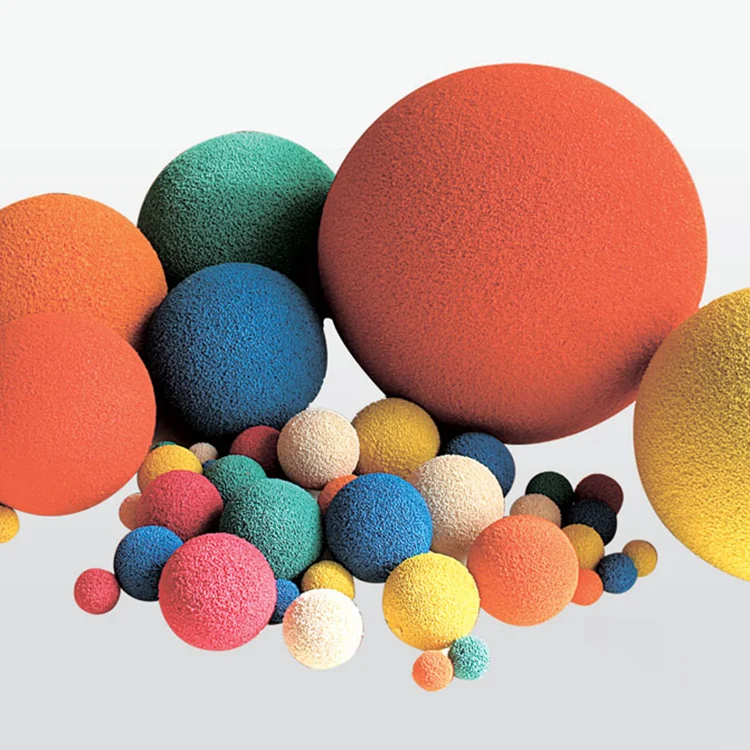Who this is for: buyers, maintenance engineers, and project managers who need a concise, practical overview before diving into specifics like sizing charts, material choices, and operating methods.
What Are Sponge Cleaning Balls?
Sponge cleaning balls are compressible elastomer balls used to wipe, sweep, or push residue from internal passages. Two major use cases dominate:
- Concrete & pipeline cleaning: removing slurry, aggregates, dust, or debris from hoses and steel pipes.
- Condenser/heat-exchanger ATCS (Automatic Tube Cleaning Systems): continuously circulating balls through condenser tubes to prevent fouling and efficiency loss.
Why they matter: they’re simple, low-cost, and effective—and when sized and selected correctly, they reduce downtime, extend equipment life, and maintain efficiency.
Core Applications at a Glance
- Concrete pumps & placing booms
- After pours: flush lines to remove residual concrete/grout.
- Works with straight lines, reducers, and bends (with correct hardness and diameter).
- Industrial pipelines
- Periodic cleaning in chemical, food, and general industrial lines (compatibility dependent).
- Condenser & chiller tubes (ATCS)
- Online cleaning: balls recirculate, wiping tube walls to limit biofouling and scaling.
- Improves heat-transfer efficiency and stabilizes energy consumption.
Related reading: “What Are Sponge Cleaning Balls? Key Uses in Concrete Pumps and Condensers.”
Sizing Basics (Keep It Simple)
Golden rule: choose a ball larger than the pipe or hose I.D. so it compresses for full-contact wiping.
- Typical oversize: 5–30%, depending on material hardness, line condition, and use case.
- Quick examples (for illustration):
- 50 mm hose → start around 60 mm ball
- 65 mm steel line → start around 75–80 mm ball
- Tight bends / fragile systems → reduce hardness before reducing oversize
Why oversize? Compression ensures wall contact for wiping; too small = bypass/leakage, too large/hard = risk of sticking at reducers or tight elbows.
Related reading: “How to Size Sponge Cleaning Balls: Pipe I.D., Oversize Rules, and Examples.”
Materials, Cell Structure & Hardness
Your choice affects grip, wiping action, durability, and passability through bends.
- Base materials
- Natural rubber: high elasticity, broad temp range for general use.
- Polyurethane (PU): excellent wear resistance, can last longer in abrasive lines.
- Cell structure
- Open-cell: breathable, compresses easily, good recovery; can carry fluid; often better surface conformity.
- Closed-cell: lower water absorption, firmer sealing feel; may slide differently on smooth walls.
- Hardness (soft / medium / hard)
- Soft: better for tight bends, delicate systems, or rough interiors.
- Medium: balanced wiping and passability—most common.
- Hard: aggressive wiping for stubborn deposits; higher risk of sticking if oversized or at sharp reducers.
Related reading: “Rubber vs. PU, Open-Cell vs. Closed-Cell: Choosing the Right Sponge Ball.”
Operation—Two Typical Scenarios
A) Concrete Line Cleaning (End-of-Shift)
- Method snapshot: send water + sponge ball (or two-ball method) through the line at controlled speed.
- Safety first: depressurize before disconnects; verify safe discharge; follow site SOPs.
- Keys to success: correct ball size + hardness, steady feed, and attention at reducers/bends.
Related reading: “Concrete Pump Line Cleaning: Methods, Steps, and Safety Essentials.”
B) Condenser/ATCS (Online Tube Cleaning)
- Loop concept: balls are injected → circulate through tubes wiping walls → captured by strainers → re-injected.
- Setup variables: ball diameter tolerance vs. tube I.D., surface finish (smooth, ridged, abrasive rings), hardness, dosing frequency (balls per tube per hour).
- Outcome: maintains clean tube surfaces, stabilizes ΔT and energy efficiency.
Related reading: “Online Tube Cleaning with Sponge Balls (ATCS): How It Works and When to Use It.”
Operating Limits, Durability & Replacement
- Temperature: check the compound’s safe range for your process (concrete/water flush vs. chiller service).
- Cycle life: depends on material (PU lasts longer), hardness, surface finish, line roughness, and dosing rate.
- Replace when: diameter shrinks noticeably, wiping performance drops, or surface degrades (tears, glazing, chunking).
Related reading: “Temperature, Elasticity, and Reuse: How Long Do Sponge Cleaning Balls Last?”
Quick Troubleshooting Snapshot
- Ball stuck at reducers/elbows
- Common causes: too hard or too oversized; rough weld seams; sharp angle.
- Fix: step down hardness or oversize slightly; inspect fittings; clear pressure safely.
- Poor cleaning
- Causes: ball too small, worn out, wrong cell structure/hardness.
- Fix: bump size, refresh balls, revisit material/cell structure.
- Excessive wear
- Causes: abrasive residue, rough pipe, over-hard ball.
- Fix: try PU or harder surface type (where safe), or smooth internal surfaces.
Related reading: “Troubleshooting Sponge Cleaning Balls: Stuck Balls, Poor Cleaning, Premature Wear.”
Buying & Spec Checklist (Copy/Paste)
When requesting a quote or placing an order, specify:
- Application (concrete/pipe cleaning or ATCS)
- Pipe or tube I.D. (not just nominal size) and reducers present
- Preferred oversize range or performance goal (gentle vs. aggressive)
- Material & cell (natural rubber / PU; open- vs. closed-cell)
- Hardness (soft/medium/hard) and surface type
- Operating temperature and medium (water, slurry)
- Cycle plan (frequency; for ATCS: dosing rate, capture/recirculation details)
Reading Guide
- Definition & use cases → “What Are Sponge Cleaning Balls?”
- Sizing rules & examples → “How to Size Sponge Cleaning Balls”
- Materials/cell/hardness → “Choosing the Right Sponge Ball”
- Concrete method & safety → “Concrete Pump Line Cleaning”
- ATCS fundamentals → “Online Tube Cleaning (ATCS)”
- Troubleshooting → “Stuck Balls, Poor Cleaning, Premature Wear”
- Durability & reuse → “Temperature & Life Limits”
- ATCS selection & dosing → “ATCS Ball Selection & Dosing Frequency”
Conclusion
Need a quick recommendation? Share your pipe/tube I.D., medium, temperature, and cleaning goal. I’ll suggest a size + hardness + material combo and link the matching short guide.

